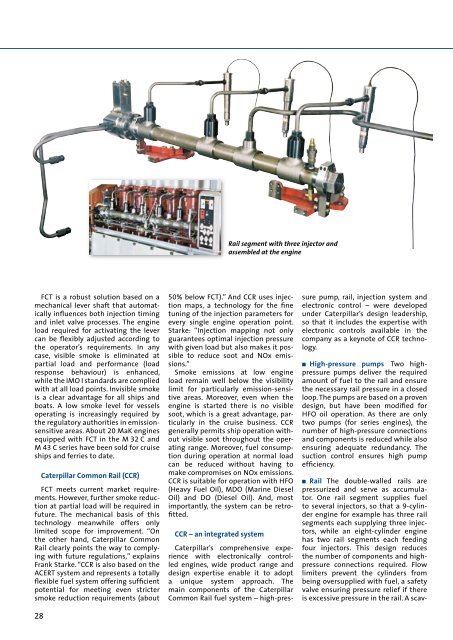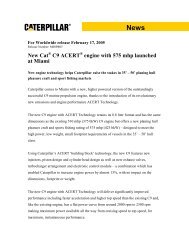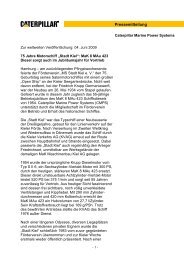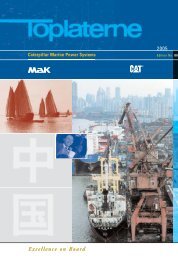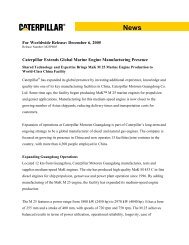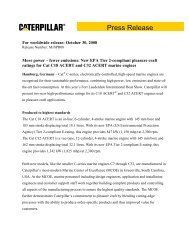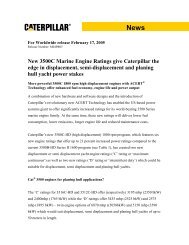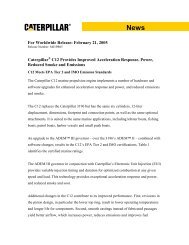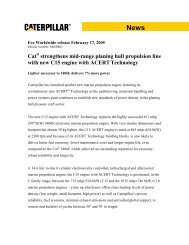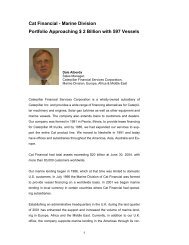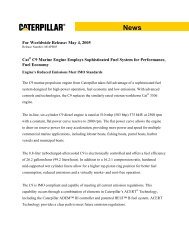Caterpillar Marine - Marine Engines Caterpillar
Caterpillar Marine - Marine Engines Caterpillar
Caterpillar Marine - Marine Engines Caterpillar
Create successful ePaper yourself
Turn your PDF publications into a flip-book with our unique Google optimized e-Paper software.
FCT is a robust solution based on a<br />
mechanical lever shaft that automatically<br />
influences both injection timing<br />
and inlet valve processes. The engine<br />
load required for activating the lever<br />
can be flexibly adjusted according to<br />
the operator’s requirements. In any<br />
case, visible smoke is eliminated at<br />
partial load and performance (load<br />
response behaviour) is enhanced,<br />
while the IMO I standards are complied<br />
with at all load points. Invisible smoke<br />
is a clear advantage for all ships and<br />
boats. A low smoke level for vessels<br />
operating is increasingly required by<br />
the regulatory authorities in emissionsensitive<br />
areas. About 20 MaK engines<br />
equipped with FCT in the M 32 C and<br />
M 43 C series have been sold for cruise<br />
ships and ferries to date.<br />
<strong>Caterpillar</strong> Common Rail (CCR)<br />
FCT meets current market requirements.<br />
However, further smoke reduction<br />
at partial load will be required in<br />
future. The mechanical basis of this<br />
technology meanwhile offers only<br />
limited scope for improvement. “On<br />
the other hand, <strong>Caterpillar</strong> Common<br />
Rail clearly points the way to complying<br />
with future regulations,” explains<br />
Frank Starke. “CCR is also based on the<br />
ACERT system and represents a totally<br />
flexible fuel system offering sufficient<br />
potential for meeting even stricter<br />
smoke reduction requirements (about<br />
28<br />
50% below FCT).” And CCR uses injection<br />
maps, a technology for the fine<br />
tuning of the injection parameters for<br />
every single engine operation point.<br />
Starke: “Injection mapping not only<br />
guarantees optimal injection pressure<br />
with given load but also makes it possible<br />
to reduce soot and NOx emissions.”<br />
Smoke emissions at low engine<br />
load remain well below the visibility<br />
limit for particularly emission-sensitive<br />
areas. Moreover, even when the<br />
engine is started there is no visible<br />
soot, which is a great advantage, particularly<br />
in the cruise business. CCR<br />
generally permits ship operation without<br />
visible soot throughout the operating<br />
range. Moreover, fuel consumption<br />
during operation at normal load<br />
can be reduced without having to<br />
make compromises on NOx emissions.<br />
CCR is suitable for operation with HFO<br />
(Heavy Fuel Oil), MDO (<strong>Marine</strong> Diesel<br />
Oil) and DO (Diesel Oil). And, most<br />
importantly, the system can be retrofitted.<br />
CCR – an integrated system<br />
Rail segment with three injector and<br />
assembled at the engine<br />
<strong>Caterpillar</strong>’s comprehensive experience<br />
with electronically controlled<br />
engines, wide product range and<br />
design expertise enable it to adopt<br />
a unique system approach. The<br />
main components of the <strong>Caterpillar</strong><br />
Common Rail fuel system – high-pres-<br />
sure pump, rail, injection system and<br />
electronic control – were developed<br />
under <strong>Caterpillar</strong>’s design leadership,<br />
so that it includes the expertise with<br />
electronic controls available in the<br />
company as a keynote of CCR technology.<br />
n High-pressure pumps Two highpressure<br />
pumps deliver the required<br />
amount of fuel to the rail and ensure<br />
the necessary rail pressure in a closed<br />
loop. The pumps are based on a proven<br />
design, but have been modified for<br />
HFO oil operation. As there are only<br />
two pumps (for series engines), the<br />
number of high-pressure connections<br />
and components is reduced while also<br />
ensuring adequate redundancy. The<br />
suction control ensures high pump<br />
efficiency.<br />
n Rail The double-walled rails are<br />
pressurized and serve as accumulator.<br />
One rail segment supplies fuel<br />
to several injectors, so that a 9-cylinder<br />
engine for example has three rail<br />
segments each supplying three injectors,<br />
while an eight-cylinder engine<br />
has two rail segments each feeding<br />
four injectors. This design reduces<br />
the number of components and highpressure<br />
connections required. Flow<br />
limiters prevent the cylinders from<br />
being oversupplied with fuel, a safety<br />
valve ensuring pressure relief if there<br />
is excessive pressure in the rail. A scav-


